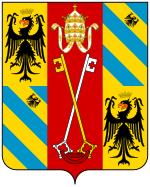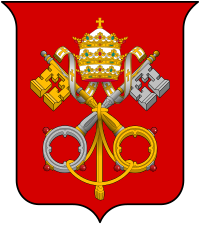The coat of arms of the Holy See combines two crossed keys and a tiara, used as a coat of arms by the Holy See. These forms have origins attested from the 14th century.[1][3] The combination of one gold and one silver key is a somewhat later development.[3][4]
Origins and background
Ecclesiastical heraldry had the same origin and developed contemporaneously with general heraldry, which had become general throughout England, France, Italy and Germany by the end of the 12th century. Ecclesiastical heraldry appears first in seals, nearly all vesica-shaped.[5][6]
When Pope Gregory IX waged war against Emperor Frederick II in 1228, papal troops were described by Richard of San Germano as "bearing the sign of the keys" (clavigeros hostes or clavesignati). The keys appeared on their banners and were sewn onto their clothing over their breasts. The conflict is consequently called War of the Keys.[7]
Keys and their arrangement
The earliest blazoning of the arms of the Holy See is that found in Froissart's Chronicles of 1353, which describes them as "gules two keys in saltire argent".[8] From the beginning of the 14th century, the arms of the Holy See had shown this arrangement of two crossed keys, most often with a gold key in bend and a silver in bend sinister, but sometimes with both keys or (gold), less often both keys silver, as described by Froissart.[3]
The practice by which the gold key is placed in bend and the silver in bend sinister was slow in establishing itself,[4] and only from the time of Pope Pius II is it found with certainty. "The practice of placing a gold key in bend over another in bend sinister of silver is not found with any certainty before the time of Pius II (1458–64)".[9]
In 1952–1953 the English Heraldry Society gave the blazon of the arms of the Holy See as "Gules a key or [("gold" or "yellow" in heraldic terminology)] in bend above a key argent [("silver" or "white" in heraldic terminology)] in bend sinister, both wards upwards, the bows united by a cord or, above the shield a tiara, its three crowns or [("gold")], the mitre argent [("silver")]".[10] In his 1978 book, Heraldry in the Catholic Church, Archbishop Bruno Heim described the same arrangement.[11]
Sede vacante

The gold key is placed in bend also in the sede vacante emblem, with the tiara replaced by an umbraculum (umbrella) said to represent the absence of a pope and the temporary governance of the Camerlengo of the Holy Roman Church over the temporal affairs of the Holy See,[12] and in the arms of the Papal States.
Tiara
By the end of Froissart's 14th century the papal tiara was included in the coat of arms of the Holy See according to Galbreath[1] and Insegne e simboli: araldica pubblica e privata medievale e moderna.[2] Claudio Ceresa, on the other hand, says the earliest known evidence of its adoption dates from the following century, in the pontificate of Martin V (1417–1431).[13]
Papal States and Vatican City

The distinction between the coat of arms of the papacy and that of the territory ruled by it dates back at least to the 16th century. Galbreath states: "From the 16th century on, this, the third coat of the Papacy — which may be blazoned Gules a pair of keys crossed in saltire, one gold, one silver, tied gold, surmounted by a tiara silver, crowned gold — is taken to represent the Papacy as distinct from the Papal States."[14] This statement is quoted with approval by Heim.[15]
The arms of the Papal States differed in having the umbraculum (the emblem of the Pope's temporal powers) in place of the tiara, and were incorporated as the first quartering of the royal coat of arms of the Napoleonic Kingdom of Italy (1805–1814).[16][17]
Charges on the escutcheon
Claudio Ceresa says that the oldest known representation of the crossed keys beneath the papal tiara dates from the pontificate of Martin V (1417–1431), whose successor, Eugene IV (1431–1447), included it in the design of a silver coin.[13] Galbreath and Insegne e simboli: araldica pubblica e privata medievale e moderna say it is attested from the previous century.[1][2]
Keys
The keys refer to the promise of Jesus Christ to Peter: "I will entrust to you the keys of the kingdom of heaven. Whatever you declare bound on earth shall be bound in heaven; whatever you declare loosed on earth shall be loosed in heaven" (Matthew 16:19). They are a symbol of the power the Catholic Church believes that Christ gave to Saint Peter and his successors.[18] The gold key signifies that the power reaches to heaven and the silver key that it extends to all the faithful on earth, their interlacing indicates the linking between the two aspects of the power, and the handles of the key being at the base symbolize the power being in the hands of the pope.[11]
Tiara
While actual wearing of the papal tiara has been discontinued by John Paul I and his successors, it remains a papal heraldic symbol. A crown was added to the headgear of the Pope in 1130 to symbolize sovereignty over the Papal States. In 1301, Boniface VIII, at that time in conflict with Philip IV of France, added a second crown to indicate that his spiritual authority was superior to any civil power. In 1342, Benedict XII added a third crown to symbolize the superiority of papal religious authority over that of non-religious monarchs. The original significance of the three crowns was lost over time and they came to represent instead the pope's powers as priest, ruler and teacher.[18]
See also
- Flag of Vatican City
- Coat of arms of Vatican City
- Fundamental Law of Vatican City State
- Holy See
- Vatican City
- Index of Vatican City-related articles
References
- ^ a b c d "A red shield bearing two white crossed keys, and surmounted by the tiara, is to be seen in a window of Bourges Cathedral accompanying the achievements of Antipopes Clement VII and Benedict XIII, and other examples of these tinctures are to be found in manuscripts dating from the time of the former of these antipopes and from that of Nicholas V, in a series of shields painted on the ceiling formerly in the church of San Simone at Spoleto (ca. 1400), in the 15th-century glass in the cathedrals of York and of Carpentras, in various 15th-century books of arms both English, German, and Italian, as well as in Martin Schrot's book of arms which is as late as 1581." Donald Lindsay Galbreath, A Treatise on Ecclesiastical Heraldry (W. Heffer and Sons, 1930).
- ^ a b c Bascapè, Giacomo C.; Piazzo, Marcello Del; Borgia, Luigi (1999). Insegne e simboli: araldica pubblica e privata medievale e moderna (in Italian). Ministero per i beni culturali e ambientali, Ufficio centrale per i beni archivistici. p. 337. ISBN 978-88-7125-159-2.
- ^ a b c "From the beginning of the 14th century, the two crossed keys constitute the arms of the papacy. The field of the shield is generally gules (red) and the cord is azure (blue). Most often the key placed in bend is gold and the one placed in bend sinister is silver; sometimes they are both gold, or, less often, silver" (Michel Pastoureau, "Keys" in Philippe Levillain, The Papacy: An Encyclopedia (Routledge 2002 ISBN 9780415922302), vol. 2, p. 891).
- ^ a b Donald Lindsay Galbreath, A Treatise on Ecclesiastical Heraldry (W. Heffer and Sons, 1930), p. 9.
- ^ Arthur Charles Fox-Davies in Catholic Encyclopedia (1910) . Catholic Encyclopedia. 1913.
- ^ "Scanned reproduction of the article, with illustrations". catholic.com. Archived from the original on 24 February 2014. Retrieved 7 March 2019.
- ^ G. A. Loud (2016), "The Papal 'Crusade' against Frederick II in 1228–1230", in Michel Balard (ed.), The Papacy and the Crusades, Routledge, pp. 92, 98; Brett Edward Whalen (2019), The Two Powers: The Papacy, the Empire, and the Struggle for Sovereignty in the Thirteenth Century, University of Pennsylvania Press, p. 36.
- ^ ""Froissart, in his Chronicles referring to the events of the year 1383, is the first to blazon the arms of the Church: faisait Vevesque de Mordwich porter devant lui les armes de l'Eglise, la bannière de St. Pierre, de gueules à deux clefs d'argent en sautoir, comme Gonfanonnier du Pape Urbain." Donald Lindsay gules, A Treatise on Ecclesiastical Heraldry (W. Heffer and Sons, 1930)
- ^ John A. Goodall, "The Sovereign Pontiff has the oldest coat of arms" in The Catholic Herald, 1 June 1956
- ^ The Heraldry Society, Coat of Arms 1952–53, vol. 2, p. 254
- ^ a b "The symbolism of the keys is brought out in an ingenious and interpretative fashion by heraldic art. One of the keys is of gold (or), the other of silver (argent). The golden key, which points upwards on the dexter side, signifies the power that extends even to Heaven. The silver key, which must point up to the sinister side, symbolizes the power over all the faithful on earth. The two are often linked by a cordon Gules as a sign of the union of the two powers. The handles are turned downwards, for they are in the hand of the Pope, Christ's lieutenant on earth. The wards point upwards, for the power of binding and loosing engages Heaven itself." Bruno Bernhard Heim, Heraldry in the Catholic Church: Its Origin, Customs and Laws (Van Duren 1978 ISBN 9780391008731), p. 54
- ^ Guruge, Anura (16 February 2010). The Next Pope. Anura Guruge. ISBN 9780615353722. Retrieved 7 March 2019 – via Google Books.
- ^ a b Claudio Ceresa, "Una sintesi di simboli ispirati alla Scrittura" on L'Osservatore Romano, 10 August 2008 Archived 18 February 2013 at archive.today
- ^ Galbreath 1930, p. 25
- ^ Heim 1978, p. 101
- ^ Giacomo P. Bascapè, Marcello Del Piazzo, Insegne e simboli. Araldica pubblica e privata medievale e moderna. Parte Terza: Araldica Napoleonica in Italia (Ministero per i beni culturali e ambientali, 1983), p. 770
- ^ "Papal Heraldry". www.heraldica.org. Retrieved 7 March 2019.
- ^ a b "Andrea Cordero Lanza di Montezemolo, "Coat of Arms of His Holiness Benedict XVI"". vatican.va. Retrieved 7 March 2019.
Further reading
- Donald L. Galbreath: Papal Heraldry. Cambridge, 1930; Heffer and Sons.
- Bruno Bernhard Heim: Heraldry in the Catholic Church: Its Origins, Customs and Laws. Gerrards Cross: Van Duren, 1978.
- Baron du Roure de Paulin: L'Héraldique Ecclésiastique. Paris, 1911; H. Daragon.

